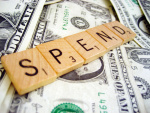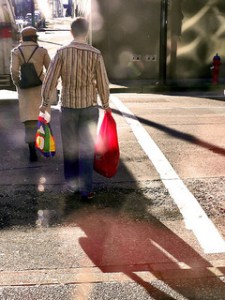![]()
 Forget twitter, Facebook and social networking. If you want real followers – the physical ones – just get yourself a roll of yellow labels. Come early evening when supermarkets start reducing short-dated produce, a rabble of anxious-looking shoppers will invariably tail staff members as they mark down food. It seems many of us are ravenous for bargains in this age of austerity.
Forget twitter, Facebook and social networking. If you want real followers – the physical ones – just get yourself a roll of yellow labels. Come early evening when supermarkets start reducing short-dated produce, a rabble of anxious-looking shoppers will invariably tail staff members as they mark down food. It seems many of us are ravenous for bargains in this age of austerity.
If you’re someone who loves snapping up deals – take some advice: avoid the high street on a sunny day. Blue skies are great for lifting the mood, but as recent research shows – it also impairs your ability to spot a shrewd bargain…
Summer shoppers spend more
 Anyone who owns a retail company will know that a good summer means more sales. When the weather is bad, people stay at home. Of course, in this era of internet shopping and undercover shopping malls, rain needn’t impede a decent dose of retail therapy. Recent research from Canada shows that our spending habits are influenced by climate in some surprising ways: shrewdness appears impaired in the presence of sunlight. Put simply, we’re more willing to spend more for the same product if the weather is good.
Anyone who owns a retail company will know that a good summer means more sales. When the weather is bad, people stay at home. Of course, in this era of internet shopping and undercover shopping malls, rain needn’t impede a decent dose of retail therapy. Recent research from Canada shows that our spending habits are influenced by climate in some surprising ways: shrewdness appears impaired in the presence of sunlight. Put simply, we’re more willing to spend more for the same product if the weather is good.
Performing three separate investigations looking at the influence of rainfall, sunshine, temperature and humidity, an analysis of sales figures confirmed that a cool sunny day does indeed boost high-street sales (but incidentally, not on a hot day). Canadian researchers went further to explore the influence of weather on shopping – on a personal level. Two cohorts of volunteers were monitored for their mood and spending both in the lab and the real world. Here’s what they discovered:
- Sunlight (both real and from artificial ‘sun lamps’) reduced negative thoughts and feelings
- Personal expenditure markedly increased on sunny days
- When asked ‘how much would you spend on…’ participants were prepared to spend more for identical products after being exposed to sunlight
Assuming these volunteers are representative of the rest of us, what is most remarkable is just how much more we are prepared to spend: Vacation-seekers would happily spend 30% more on an airline ticket ($518 after sun, $400 without); and we would all happily lob out $9 (£5.50) a month more on a gym membership. Even spending on soft drinks and newspapers goes up significantly.
Researchers Murray, Muro and colleagues conclude that as clouds dissipate, depression lifts and our financial perspective gets skewed. Although not entirely ground-breaking, this research forms the first direct link between sunshine, mood and our wallets. It also has real life applications: Shopping outlets could put a fair-weather -premium on their products and probably get away with it.
So, if you’re counting the pennies then it is best to head to the countryside, away from the shops, to enjoy nature in a happy sunny mood.
And if you’re a miser, you now have an excuse. Blame the weather.
Thanks for reading - feel free to comment below…
Follow @realdoctorstu
.
REFERENCES:
Murray, K., Di Muro, F., Finn, A., & Popkowski Leszczyc, P. (2010). The effect of weather on consumer spending Journal of Retailing and Consumer Services, 17 (6), 512-520 DOI: 10.1016/j.jretconser.2010.08.006
Related Posts:










Hi Dr.,
I have a feeling the findings would be different among natives of tropical countries. Or maybe it’s just me. Interesting study to be replicated in a different climate and culture. 🙂
Posted by shah8008 | April 8, 2012, 12:27 pmI agree. It’s an interesting study - but needs repeating with greater sample sizes and across different cultures.
I wonder whether it is a cultural or a biological response? I suspect the response to physiological mood-lifting by sunlight / blue light alters behaviour, but in a consumeristic Western culture this manifests as increased shopping. I’m sure in other cultures there would be a different behavioural response.
Posted by Stuart Farrimond | April 10, 2012, 9:05 am